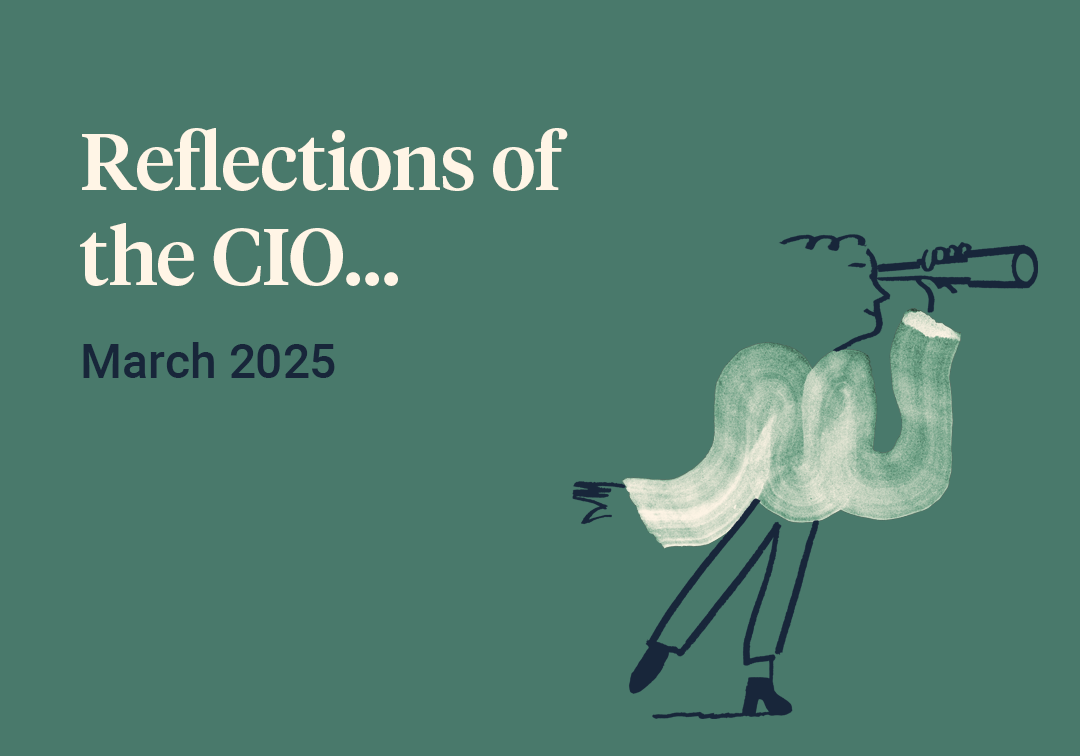With our CIO, David Cooke, currently travelling the Norwegian fjords, this month’s reflections come from the Head of Research, Charlie Ambler.
Whilst the weather in July, here in the UK, has been wholly underwhelming, inflation data did its best to brighten the mood and lift some of the gloominess in stock and bond markets alike. It’s taken well over a year for the UK to have some positive inflation news, but in July it came pouring in. Both headline and core CPI data came in below expectations and, in a world where -0.1% undershoots (versus estimates) can be material for markets, the -0.3% and -0.2% misses respectively were very well received. None more so than by the Bank of England, which had spent the last 14 consecutive months hiking rates in an attempt to curb rising inflation. Unlike across the pond, the UK was yet to see any meaningful downward shifts, having peaked at over 10% earlier in the year and, rather even more worryingly, having stayed flat between April and May, at 8.7%. June’s inflation print (released in July) offered hope that the rate hikes were beginning to work in their intended fashion: reducing spending; promoting saving; and, hopefully, allaying fears of a spiral.
Critics of the recent monetary policy shifts suggested that the current plan was doomed from the start, as the Bank of England was tackling a supply-based issue with demand-focused measures. The latest data would suggest that there is clearly merit in the approach they have taken. However, bearing in mind food and beverage inflation still remains north of 15%, there continue to be major challenges ahead. None more so than the fact that there is a material time lag between a rate hike and its full effects to be felt. Economists put this lag at anywhere up to 18 months. Combine this with the issue that inflation data is backward looking by a year (so the latest point is the difference in prices between June 2022 and June 2023) and its not hard to see why it’s so difficult for Central Banks to get it right. Imagine you are driving a car, but you are only allowed to look out the back window and any changes you make to steering or speed are delayed by an unknown amount of time!
Do you need help managing your investments?
Our team can recommend an investment strategy to meet your financial objectives and give you peace of mind that your investments are in good hands. Get in touch to discuss how we can help you.

In the US, where inflation hits and misses are felt much more globally, July was a quieter month. Inflation came in lower than expected, but core inflation proved stickier. This provided a mixed signal for markets, albeit a positive one at the margin. The Federal Reserve put through a fairly well telegraphed 25bps hike, raising the base rate to 5.25%, but what is more interesting is their next move from here. Markets have priced in last month’s move as the final one for this cycle, the Fed however have remained resolute in their desire to be pragmatic. Fed Chair Jerome Powell refused to rule out further hikes, stating instead that any decision from here would be ‘data-driven’. What this could mean for markets is that we are entering a period where good news for the economy is bad news for markets. Any positive economic news will likely increase the probability of further interest rate hikes which, in turn, will lead to increased likelihood of cracks appearing and something breaking – bad news for markets. From here, the best course for markets is a controlled economic slowdown but not to recessionary levels, what’s known in economic terms as ‘soft landing’; where unemployment rises substantially. The probability of this has slowly been increasing, hence the strong performance of markets so far this year, but we are far from out of the woods.
Looking further East and the picture looks very different. In July, the Chinese Government had to intervene in the wake of faltering economic growth. They opted for some monetary policy easing, whilst markets are expecting further stimulus to come. It would appear the inverse is true here, where ‘bad news is good news’. The Chinese stock market actually performed well in July, as the bad economic news forced government intervention. The problem facing many of these policy makers is that they aren’t functioning in their own little bubble. Chinese stimulus expectations pushed commodity prices higher throughout July, which in turn feeds inflation expectations globally. The Bank of England and Federal Reserve can raise interest rates all they want, but people still need to buy food, and those prices are heavily affected by the cost of the raw materials. To bring it back to the driving analogy, not only do you have all same issues as before, but there are also external forces shifting the speed and direction of the car, many of which you can’t see coming!
Putting this all together and you can see why the outlook is as murky as the weather. Currently there are areas that seem too optimistic for our liking. Areas like these need a lot to go right from here to justify their current valuations. We are taking profits in these areas and looking more towards the unloved parts of the markets. Places where doom and gloom remain firmly entrenched and valuations are only justified if the current outlook prevails in its worst sense. One thing that always rings true is that markets, much like the UK weather, are ever-changing. We remain very active in our approach to both asset allocation and our selection of managers, and ever wary of buying a story rather than a fact.
Do you need help managing your investments?
Our team can recommend an investment strategy to meet your financial objectives and give you peace of mind that your investments are in good hands. Get in touch to discuss how we can help you.

Article sources
Editorial policy
All authors have considerable industry expertise and specific knowledge on any given topic. All pieces are reviewed by an additional qualified financial specialist to ensure objectivity and accuracy to the best of our ability. All reviewer’s qualifications are from leading industry bodies. Where possible we use primary sources to support our work. These can include white papers, government sources and data, original reports and interviews or articles from other industry experts. We also reference research from other reputable financial planning and investment management firms where appropriate.
The views expressed in this article are those of the Saltus Asset Management team. These typically relate to the core Saltus portfolios. We aim to implement our views across all Saltus strategies, but we must work within each portfolio’s specific objectives and restrictions. This means our views can be implemented more comprehensively in some mandates than others. If your funds are not within a Saltus portfolio and you would like more information, please get in touch with your adviser. Saltus Asset Management is a trading name of Saltus Partners LLP which is authorised and regulated by the Financial Conduct Authority. Information is correct to the best of our understanding as at the date of publication. Nothing within this content is intended as, or can be relied upon, as financial advice. Capital is at risk. You may get back less than you invested. Tax rules may change and the value of tax reliefs depends on your individual circumstances.
Related blog posts
About Saltus?
Find out more about our award-winning wealth management services…
Winner
Best Wealth Manager
Winner
Investment Performance: Cautious Portfolios
Winner
Top 100 Fund Selectors 2024
Winner
Best Places to Work 2024
£8bn+
assets under advice
20
years working with clients
350+
employees
97%
client retention rate


